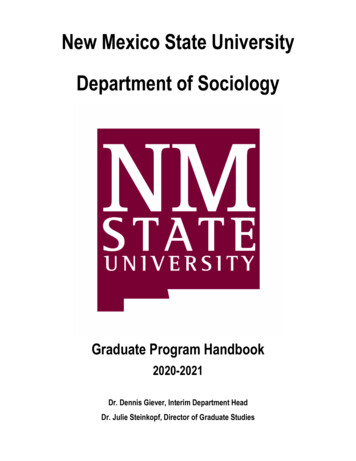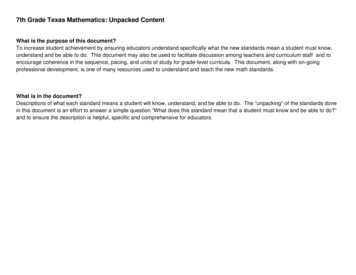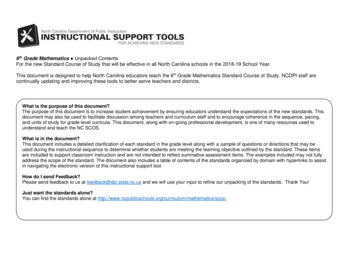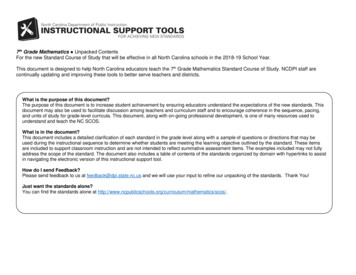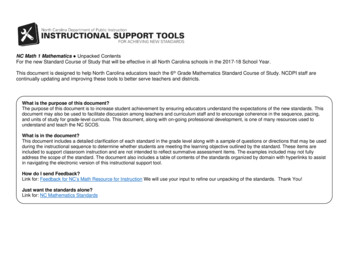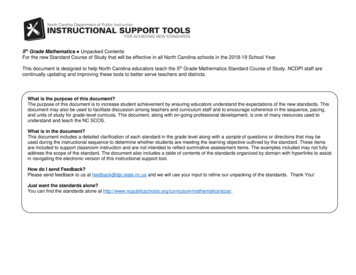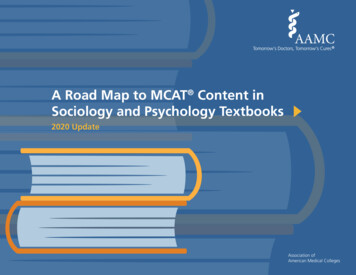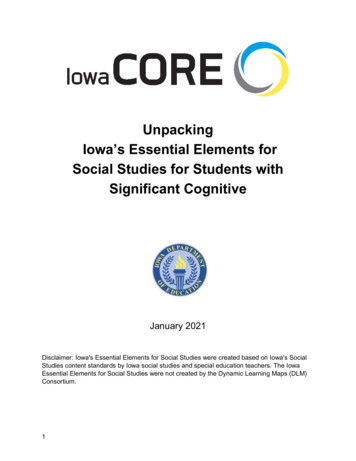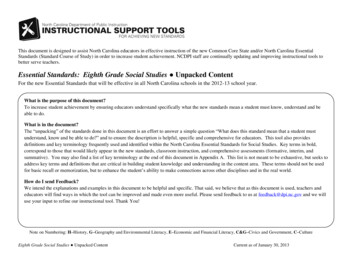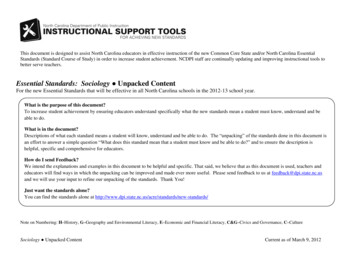
Transcription
This document is designed to assist North Carolina educators in effective instruction of the new Common Core State and/or North Carolina EssentialStandards (Standard Course of Study) in order to increase student achievement. NCDPI staff are continually updating and improving instructional tools tobetter serve teachers.Essential Standards: Sociology Unpacked ContentFor the new Essential Standards that will be effective in all North Carolina schools in the 2012-13 school year.What is the purpose of this document?To increase student achievement by ensuring educators understand specifically what the new standards mean a student must know, understand and beable to do.What is in the document?Descriptions of what each standard means a student will know, understand and be able to do. The “unpacking” of the standards done in this document isan effort to answer a simple question “What does this standard mean that a student must know and be able to do?” and to ensure the description ishelpful, specific and comprehensive for educators.How do I send Feedback?We intend the explanations and examples in this document to be helpful and specific. That said, we believe that as this document is used, teachers andeducators will find ways in which the unpacking can be improved and made ever more useful. Please send feedback to us at feedback@dpi.state.nc.usand we will use your input to refine our unpacking of the standards. Thank You!Just want the standards alone?You can find the standards alone at dards/Note on Numbering: H–History, G–Geography and Environmental Literacy, E–Economic and Financial Literacy, C&G–Civics and Governance, C–CultureSociology Unpacked ContentCurrent as of March 9, 2012
HistoryEssential Standard:12.H.1 Understand the discipline of sociology using various perspectives and research methods.Concept(s):Clarifying ObjectivesUnpacking12.H.1.1 Explain the development ofsociology as a social science.What does this standard mean a student will understand, know and be able to do?The student will understand that: The study of human relationships reveals the ideals, beliefs, values, and institutions of a culture. The study of human nature reveals the ideals, beliefs, values, and institutions of a culture.For example:Sociology, pioneered by Auguste Comte, developed after the American and French Revolutionswhen the concepts of individualism and equality were developing and different aspects of social lifebegan to be studied, using the five key concepts of social structure, social action, functionalintegration, power, and culture.The student will know: Sociology is a empirical science that uses research methods to analyze data objectively in order tostudies human society in the social world. Some of the early sociologists include Auguste Comte, Herbert Spencer, Emile Dukheim, MaxWeber The difference between Sociology and other social sciences i.e. psychology, anthropology, andpolitical scienceSuggested ://www.asanet.org/teaching/resources.cfmSociology Unpacked ContentPage 2 of 22Current as of March 9, 20112
12.H.1.2 Compare the theoreticalperspectives of functionalism,conflict, and symbolicinteractionism used to explain socialphenomena.The student will understand that: Theoretical perspectives can explain social phenomena.For example:Structural Functionalism sees a family as a complex structure with many interacting parts. Conflictperspectives see the family as an institution that may perpetuate social inequalities. SymbolicInteraction sees the family as defined by the relationships established in it.The student will know: Theoretical perspectives such as functionalism, conflict, and symbolic interactionism may be used toexplain social phenomena.For example:The five key concepts of sociology helps explain social phenomena, that is, the behavior thatinfluences humans to live and relate to one another.Suggested ta-discourses/Papers/App ng-for-specific-fields/sociology12.H.1.3 Use quantitative andqualitative studies and methodssuch as surveys, polls, and statisticsto conduct sociological research.The student will know: Quantitative and qualitative studies are used to conduct sociological research. People may learn about the social world through researchFor example:Surveys, polls, interviews, experiments, and statistics are examples of research methods and studiesthat are used in sociological research.The student will be able to: Conduct research using both quantitative and qualitative methodology.For example:Sociology Unpacked ContentPage 3 of 22Current as of March 9, 20112
Statistical, mathematical or computational techniques (quantitative) and the why and how ofdecision making (qualitative) are used to gather an in-depth understanding of human behavior andthe reasons that govern such behavior.Suggested Resources: http://www.socresonline.org.uk/ .4 Evaluate varioussociological research studies andmethods in terms of samplingtechniques, bias, validity, reliability,applicability and ethics.The student will understand that: Research studies and methods may not always be free of bias, valid, reliable, applicable, or ethical.For example:Emile Durkheim used empirical research to explain the social causes as to why people attempt orcommit suicide.The student will know: Various sociological research methods and how they can be applied to explain human behavior. How to evaluate research studiesFor example:The methodology of the scientific method, as used in sociology, uses the seven step Durkheimmodel to conduct research on human behavior.The different sampling techniques used in researchThe difference between validity and reliabilityExamples of ethical behavior in sociological researchSuggested Resources: http://www.asanet.org/about/ethics.cfm -The American Sociological Association’s Code of Ethics html http://www.socresonline.org.uk/Sociology Unpacked ContentPage 4 of 22Current as of March 9, 20112
CultureEssential Standard:12.C.1 Understand how cultures and its diversity sustain hat does this standard mean a student will understand, know and be able to do?12.C.1.1 CompareThe student will understand that: The human behavior over time and across cultures exhibit similar patterns.various cultures using the People across the world live life and interact in very different wayssociological perspectives.For example:Comparing the similarities of two African tribes helps sociologists understand African cultures.The student will know: How to study various cultures from the sociological perspective to understand human behavior.For example:In comparing cultures, students need to be cognizant of bias such as ethnocentrism, relativism, so as to study theculture as it is and not how it is in comparison to one’s own culture.The basic elements of culture include knowledge, language, symbols, values, norms, beliefs, and artifacts.Ideal Culture, Real Culture, Culture Shock, Cultural Diffusion, AssimilationSuggested Resources: Human Culture: What is Culture? http://anthro.palomar.edu/culture/culture 1.htmSociology Unpacked ContentPage 5 of 22Current as of March 9, 20112
12.C.1.2 Exemplifyvarious subcultures andhow they distinguishthemselves from thelarger fmThe student will understand that: Groups distinguish themselves from each other through values, beliefs, and practices.For example:Cultural diversity and subcultures - ethnic subcultures such as HispanicsThe student will know: Examples of how groups distinguish themselves from the larger culture through their values, beliefs, andpractices. How sociologists relate subcultures and countercultures to mainstream culture.For example:Variation in language among people in different locations of the US may be part of subcultures.Suggested Resources: tercultures-and-subcultures-id1524.php lture/subcultures and countercultures.htm Video: Do You Speak American?, Supporting materials at http://www.pbs.org/speak/12.C.1.3 Explain theinfluence of values,norms, folkways, andmores on people’sbehaviors within culturesand subcultures of theUnited States.The student will understand that: Normal behavior may be defined differently in different cultures.For example:Rules of etiquette vary from culture to culture. Norms and values may vary among different subcultures in the United StatesValues may help to shape the norms of a culture.The values of a culture may change over time.The student will know: How sociologists define values, norms, folkways, and moresSociology Unpacked ContentPage 6 of 22Current as of March 9, 20112
Folkways, Mores, and Laws are types of social normsSanctions are punishments and rewards that encourage conformity to norms.Williams’ Theory of American ValuesExamples from history of how values have influenced the behavior of a cultureNote: An interesting article on African American etiquette that may be a good starting point for conversation tte.htm, for teachers to read.Suggested Resources: http://savior.hubpages.com/hub/basicconceptculture .4 Comparedifferent types ofsocieties, such asagrarian, industrial, andpost-industrial.The student will understand that: Different types of societies may emerge based on the values of the people in them.For example:Agrarian, industrial, and post-industrial societies develop as peoples values and economic capabilities havechanged.The student will know: How a society differs from a culture Differences between types of societiesFor example:Compare the different types of societies in terms of government, economy, standard of living, education, etc.Suggested Resources: ex.php ogy Unpacked ContentPage 7 of 22Current as of March 9, 20112
Essential Standard:12.C.2 Understand how socialization regulates individual 2.C.2.1 Analyze thetheoretical developmentof perspectives onsocialization.The student will understand that: The way people understand society and culture may be influenced by several factors. People may view the process of socialization differently.What does this standard mean a student will understand, know and be able to do?The student will know: Socialization is the lifelong process of learning one’s culture and the acceptable behavior within it Major theories of socialization include Cooley’s Looking Glass Self, Mead’s Social Self, Piaget’s Theory ofDevelopment of Reasoning, Freud’s Theory of Personality. Ways the different theoretical perspectives view the process of socialization.Suggested Resources: s%20in%20sociology/9%20socialization.htm Pratt, Cytnhia W., Janice G. Rienerth, and Meredith Jones. The Creative Sociology Classroom. 1. 1. BlowingRock: Integrity House Publishing, 2006. 33-40. Print. .C.2.2 Analyze theroles of the family,school, peer groups, andmedia in socializingadolescents.The student will understand that:Many factors may influence behaviors, values and beliefsSome factors may influence behaviors, values, and beliefs more strongly than othersThe social environment may impacts one’s socializationFor example:Isolation and heredity may impact socializationSociology Unpacked ContentPage 8 of 22Current as of March 9, 20112
The student will know: How agents of socialization contribute to the socialization process Functions of the family include procreation, socializing future generations, teaching morals and values,transmitting language. Family is the primary agent of socialization for most people. Functions of schooling include transmitting culture and knowledge, socialization, tracking and developing futuretalents, generating social change, producing new knowledge and technology. Media portrays what becomes acceptable images of males and females. The peer groups allows people to experience conflict, cooperation, competition, and role-models that teachabout the norms of a culture.Suggested Resources:Film: Goodman, Barak. 2001. Frontline: The Merchants of Cool. Boston: WGBH Educational Foundation.(This film deals with how the media markets to ll/www/Theorists/Durkheim/index2.htm12.C.2.3 Explain theimpact of socialorganizations (such asfamilies), socialstructures (such asmarriage), and socialinstitutions (such asschools) on individualsand groups withinsociety.The student will understand that:The individual and a society may be impacted by social structuresPeople learn cultural ways through different means of social interactionsThe student will know: Families often perpetuate their values and beliefs to their children. What is and is not taught in schools shapes the views of individuals. How sociologists define role, status, achieved status, ascribed status, status set, master status, role conflict, rolestrain, role exit and how these ideas shape a person’s behavior.For example:A person who defines their master status as “teacher” may behave differentlytheir master status as “mother”.from a person who definesSuggested ocuments/CurriculumIntroSoc032709.htmlSociology Unpacked ContentPage 9 of 22Current as of March 9, 20112
http://www.asanet.org/teaching/resources.cfmPratt, Cytnhia W., Janice G. Rienerth, and Meredith Jones. The Creative Sociology Classroom. 1. 1. BlowingRock: Integrity House Publishing, 2006. 67-80. Print.12.C.2.4 Compare theformal and informalsocial organizations,structures, andinstitutions of the UnitedStates with globalsocieties.The student will understand that: Different types of social groups may shape a society.For example:Families, circle of friends, classmates, churches, corporations may influence people.The student will know: The difference between social groups and formal organizations Characteristics of primary social groups, secondary social groups, and networks Characteristics of formal organizations and bureaucraciesSuggested -individual/formal-and-informal.php12.C.2.5 Use knowledgegained from research onsocialization to managedaily problems andimprove the quality oflife.The student will know:How to apply research on socialization to daily problemsHow people solve problems connected to socializationWhen desocialization and resocialization are needed to modify a person’s thought processes and behaviors to asocially acceptable standard.The student will be able to: Apply the research studied in class to daily problems in their schools and communities.For example:Use the methodologies described in Theda Skocpol’s States and Social Revolutions and comparative analysis topredict trends.Suggested Resources:Sociology Unpacked ContentPage 10 of 22Current as of March 9, 20112
Excerpts from Theda Skocpol’s States and Social 09/11/30/states and social revolutions/ http://www.asanet.org/teaching/HighSchool.cfm http://video.pbs.org/video/2186572187/ Essential Standard:12.C.3 Analyze human behavior in terms of conformity and deviance.Concept(s): conformity, deviance, society, cultureClarifyingObjectivesUnpackingWhat does this standard mean a student will understand, know and be able to do?12.C.3.1 Analyze several The student will understand that: Deviance may be defined and explained through varying perspectivessociological theories What is deviant in one culture may not be deviant in another culturerelated to conformity anddeviance according to thedifferent theoreticalFor example:Looking someone in the eye when speaking to them is not considered deviant in some cultures but breaks socialperspectives.norms in other cultures.The student will know: How each theoretical perspective approaches the study of devianceFor example:Structural Functionalists may say that deviance is only deviance in the presence of social normsSeveral theories related to the study of deviance such as the Labeling Theory, Merton’s Strain Theory,Sutherland’s Differential Association, and Hirschi’s Control TheorySociology Unpacked ContentPage 11 of 22Current as of March 9, 20112
Suggested Resources: and.html ocialcontrol.php p %20sociology/6%20deviance%20theories.htm http://www.valdosta.edu/ klowney/devtheories.htm12.C.3.2 Analyze thedevelopment ofconformity to standardsin American society andhow deviance develops inindividuals or groups.The student will understand that: People may choose to conform or not to conform to the norms of a groupFor example:Freedom Riders chose to go against the norms of southern society through civil disobedience.The student will know: Deviance occurs for a variety of reasons and to varying degrees Violations of norms that are not in law can produce less serious consequences that violating norms that are inlaw (for example, wearing white after Labor Day will not result in an arrest) The difference between norms, mores, folkways, and laws Laws classify levels of deviance such as misdemeanors and felonies Conformity is encouraged through a variety of social controls Deviance is not always negative, it can be positive Deviance is a learned behaviorFor example:A child learning “bad” words from the people around them.Suggested Resources: http://www.asanet.org/teaching/HighSchool.cfm Asch Conformity Experiment http://www.youtube.com/watch?v TYIh4MkcfJA12.C.3.3 Analyze ways inwhich society uses socialcontrol to discourageSociology Unpacked ContentThe student will understand that: Society may use different techniques to encourage conformity Different societies have different expectations for human behavior.Page 12 of 22Current as of March 9, 20112
deviant behavior. Deviant behavior may be punished.For example:The Milgram Experiment on obedienceThe student will know: Society can use formal and informal means to control social behaviors.For example:If a person makes an inappropriate comment, the range of social controls used to change behavior may rangefrom another person pointing out the inappropriateness of the comments to a lawsuit or loss of a job due to thecomments.Money and needing to keep a job can be a form of social control to encourage conformity in the workplace. Punishment may be used to control deviant behaviorFor example:Violations of the law may result in a range of legal action, such as probation, incarceration, and capitalpunishment.Suggested Resources: Milgram Experiment: http://www.youtube.com/watch?v W147ybOdgpE&feature related http://www.soc.umn.edu/research/trc.html12.C.3.4 Analyzecountercultures in termsof their development andinfluence on society.The student will understand that: Countercultures influence their communities to varying degrees Countercultures may develop to challenge mainstream cultureFor example:Hippies protesting again the Establishment culture of the 1960s.Sociology Unpacked ContentPage 13 of 22Current as of March 9, 20112
The student will know: How countercultures develop How countercultures influence society How countercultures define themselves That countercultures are defying mainstream societySuggested Resources: lture/subcultures and countercultures.htm The Making of a Counter Culture - Reflections on the Technocratic Society and Its Youthful Oppositionhttp://www.ucpress.edu/book.php?isbn 978052020122412.C.3.5 Use knowledgegained from theoreticalanalysis on deviance andconformity to managedaily problems andimprove the quality oflife.The student will know: What constitutes deviance in a given society How deviant behavior effects society What methods does society use to encourage conformityThe student will be able to: Identify examples of deviant behavior in his or her society Analyze the causes of deviant behavior Evaluate methods that encourage conformityFor example:A student may notice that deviance is controlled in the school setting through peer pressure, rules andpunishments, and other social controls.Suggested Resources: http://www.asanet.org/teaching/HighSchool.cfm http://www.asanet.org/introtosociology/home.html http://www.people.vcu.edu/ jmahoney/deviance.htmSociology Unpacked ContentPage 14 of 22Current as of March 9, 20112
Essential Standard:12.C.4 Analyze human relationships in terms of inequality and stratification.Concept(s):Inequality, social stratification, social class, .1 Analyze thetheoretical developmentof perspectives on socialproblems related toinequalities andstratification.The student will understand that: Theories may help to explain social problems. Social problems may be relative to time, social group, power, and ideology. People may divide themselves based on many different classificationsWhat does this standard mean a student will understand, know and be able to do?For example:Divisions in society occur based on race, gender, social class, age, and sexual orientationThe student will know:How sociologists define a social problemFor example:Poverty resulting from class differences.How each theoretical perspective views problems of inequalityFor example:Discrimination based on race, gender, sexual orientation, age can be viewed differently through the differentperspectives.How sociologists define social stratificationWhat differences are the basis for social stratificationSociology Unpacked ContentPage 15 of 22Current as of March 9, 20112
Suggested Resources: http://www.trinity.edu/mkearl/strat.html “That’s Not Fair!” A Simulation .C.4.2 Analyze howindividuals and groupsrespond to and resolveissues of discrimination.The student will understand that: People may handle discrimination in different waysFor example:Laws attempt to resolve issues of discrimination, groups have marched in response to discrimination, andindividuals have used civil disobedience in order to bring attention to discrimination.Resolution to issues of discrimination may take long periods of time, even generations.The student will know: various methods of responding to and resolving issues of discriminationFor example:Mediation to resolve conflicts over gender inequality.Suggested Resources: ce-and-discrimination-against-people-learnin http://www.trinity.edu/ mkearl/race.html12.C.4.3 Analyze howsocial inequalities andstratifications areperpetuated by socialinstitutions.The student will understand that: Social inequalities may be sustained through the involvement of social institutions.For example:A society may look unfavorably on a marriage where the woman makes more money than the man, two peopleof different races are married, or one person in the marriage comes from a more significantly wealthybackground than the other partnerThe student will know: Social inequalities can be influenced by social institutionsSociology Unpacked ContentPage 16 of 22Current as of March 9, 20112
Social inequalities are associated with marriage, families, schools, religion, political systems, and economicsystemsFor example:Only one black President has ever been elected and no females have ever been elected President or VicePresident.For example:College education can be very expensive, therefore excluding some students who do not have the financialcapability to attend. Social stratifications cross social, economic, political, and ideological dimensionsFor example:There are correlations between social class and political party affiliationsSocial mobility is difficult for some groups to obtainSuggested rninhttp://www.sociologyguide.com/socia inequality exclusion/prejudices.php12.C.4.4 Analyze howThe student will understand that: People relate to each other according to their differences.socioeconomic class, race, Social inequalities may make for difficulties in social relationshipsethnicity, gender andsocial standing impactrelationships.The student will know: How to determine the impact that socioeconomics, race, ethnicity, gender and social standing have onrelationshipsFor example:Inequality impacts all types of relationship including social relationships, friendships, marriages, familyrelationships, workplace relationshipsSociology Unpacked ContentPage 17 of 22Current as of March 9, 20112
Suggested Resources: ocial-class-curricula.pdf http://www.trinity.edu/ mkearl/strat.html Video: People Like Us from PBS. Companion website at http://www.pbs.org/peoplelikeus/12.C.4.5 Use sociologicalperspectives oninequality andstratification to solveproblems and improvethe quality of life.The student will know: That sociological perspectives can help solve social problems and improve one’s quality of lifeThe student will be able to: Apply sociological perspectives to social problems to improve the quality of life Analyze the causes of social problems related to social inequalitiesFor example:A student will be able to see issues of inequality in the school setting and be able to promote change.Suggested Resources: tm http://www.sssp1.org/Essential Standard:12.C.5 Analyze the changing nature of society and the collective responses to change.Concept(s): Change, Society, Economics, War, Politics, technology, movementsClarifyingObjectivesUnpackingWhat does this standard mean a student will understand, know and be able to do?12.C.5.1 Analyze theThe student will understand that: Sociologists have different theories to try to explain the changing nature of societytheories that explain the Many factors may contribute to the way society changes over timechanging nature ofsociety and the collectiveresponses to such change.Sociology Unpacked ContentPage 18 of 22Current as of March 9, 20112
For example:Economy, technology, discovery and invention, media, political changes all may influence the way a societyapproaches daily lifeThe student will know: Several theories that attempt to explain the changing nature of societyFor example:Parson’s Theory from the Functionalist Perspective, Dahrendorf’s Theory from the Conflict Perspective,Tonnies Theory from the Symbolic Interactionism Perspective How to analyze the collective responses to society’s changesWhat is collective behavior and what are some ways it is exhibitedSuggested ww.umsl.edu/ keelr/3210/3210 lectures/conflict theory.html12.C.5.2 Analyze socialchange in terms of theinfluences oftechnological andindustrial development.The student will understand that: Technology and industrial development have influenced social change Society’s daily operations may change when new technologies emergeFor example:The cell phone, the computer, and social network websites have all contributed to changing the way peoplecommunicate with each otherThe student will know: Specific examples of how technology and industrial development has changed societyHow industrialization leads to changeFor example:Technologies have moved agricultural societies into industrial societies, which changes the way economicactivities are handledSociology Unpacked ContentPage 19 of 22Current as of March 9, 20112
Characteristics of postindustrial societiesSuggested Resources: racteristics-of-Industrial-Society.php .C.5.3 Analyze socialchange in terms of theinfluences ofgovernmental policy andlaws.The student will understand that: Governmental policy and laws influence social change Society’s daily operations may change when new law and policies emergeFor example:Civil Rights Acts, Suffrage, and Prohibition have affected the way Americans live and interact with each other.For example:Nuremberg Laws and the breaking up of the Soviet Union affected the way the people in those countries livedand interacted with each other.The student will know:Governmental policy and laws can influence social changeThe difference between power and authorityHow the type of government in a country shapes the way people react to changeFor example:Germans adjustment to life in a unified country once the Berlin Wall came downSuggested Resources: The Fall of the Berlin Wall - A Personal Account http://andreas.com/berlin.html Life After the Holocaust - http://www.ushmm.org/wlc/en/article.php?ModuleId 10007193 .5.4 Analyze socialchange in terms of theSociology Unpacked ContentThe student will understand that: War and other conflicts perpetuate social changePage 20 of 22Current as of March 9,
Sociology is a empirical science that uses research methods to analyze data objectively in order to studies human society in the social world. Some of the early sociologists include Auguste Comte, Herbert Spencer, Emile Dukheim, Max Weber The difference between Sociology and
